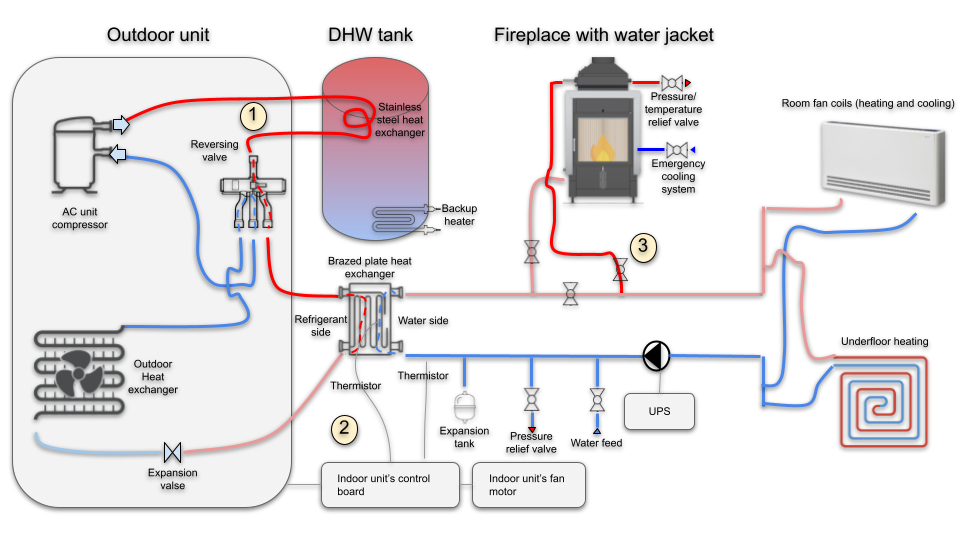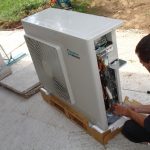When I was building my house, I had to figure out what to use for heating/cooling plus a hot domestic water solution. I came to think that the best for my case is to use a heat pump. The advantages are obvious – a heat pump moves heat/cold using somewhere up to ¼ of the electricity needed to produce that amount of energy with resistive electric heaters. So I ended up looking at Daikin Altherma as a solution. Well, until I found out about the price and a quite annoying shortcoming. The Altherma can’t heat the house and the hot water tank at the same time.. so that means I have to wait for the hot water tank to warm up to the setpoint before the house can be heated. Taking a bathtub will leave me without heating for at least an hour. No good for me. So I came across a local forum topic where some guys are discussing the option to hack a split-type air conditioner into an air-to-water type system that also takes care of domestic hot water. 
(1) Indicates the modification in the outdoor unit – the refrigerant is now routed to the DHW first. This allows for hot water to be generated regardless of the operating mode (cooling or heating)
(2) The indoor unit’s electronics and fan remain. The rest is discarded.
(3) Bypass valves for the supplementary fireplace with a water jacket.
I ordered a 120L non-corrosive steel hot water tank with two heat exchangers in it – one will be used for the refrigerant and the other is a spare one, I plan to have a fireplace connected to the water system at some point in time and will hook that to the water tank as well. The heat exchangers have been carefully designed with the help of local forum gurus. The indoor heat exchanger of the air conditioner is replaced with a brazed plate steel heat exchanger. The electronics from the unit is extracted and used to control the system. The air temperature thermistor is trimmed with an extra resistor, to accommodate for the expected lower temperature of the fluid compared to the original design with air and placed on the returning cold water outlet of the brazed plate heat exchanger. The original indoor unit tube thermistor is placed unmodified in the middle of the brazed plate heat exchanger.
That setup provides me 120L of domestic hot water regardless of the operating mode, heating, or cooling. I have invested extra efforts to make sure the house is overly well insulated to accommodate for the low-temp heat pump setup I have in place.
The heat pump I used is a Daikin FTX71GV / RX71GV. Needless to say that all warranties are voided, but worth the risk.
To monitor the heat pump and provide some controls have created a special Arduino-based system that I will be describing in a post to follow.
I use the system for a second year now and am extremely pleased with the results. My electricity bill is ridiculously low for what I get.
Here are some pictures









Pingback: Hot water usage analysis | Martin's corner on the web
Hi Martin,
Thanks for sharing! I realized you used the tank hydraulic tube heat exchanger to do the heat transfer. Haven’t you had any problems with leaks? I’m asking this because generally these tube heat exchangers are sized to pressures like 10bar, while you will get probably higher pressures when using refrigerant.
Do you have any additional info you can share concerning heat exchanger design? I am really interested on this.
Thanks again!
Hi,
this is no ordinary water tank, it was custom-ordered with two heat exchangers inside: one is for the refrigerant, smaller diameter stainless steel tubes, and the other is reserved for a fireplace with water jacket. So it can handle the pressures with no problem, we tested with 2x the maximum pressure.
I am no expert in this area and had an heat-pump expert make the specification and calculations to the hot water tank factory (tube length, diameter etc). The custom water tank cost me ~450 Euro, it is 120 l but if I were to do this again, I’d go for larger volume.
Hi Martin,
Have you done any testing yet with flow temperatures and electricicty consumption to calculate the COP (coefficient of performance) your getting?
Sam
Hi,
the trick here is that in order to calculate COP I’d have to see how much power is put into the hot water tank, and add that to the power released onto the heating contour. For the first part I calculate the power using indirect method, based on the increase of its temperature over time using the same method as described here http://harizanov.com/2012/05/measuring-the-solar-yield/; for the second component it would require a flow meter that I don’t have installed…yet
Martin –
Where were you two months ago! I’ve been battling with finding a cost effective solution for an air-to-water heat pump for the the past 6 months. I’m in the US (west coast, Oregon state) and have an all electric home. I have all radiant hydronic heat (low temp in slab basement and mid temp staple up between the joists). I would love to capture the efficiency of heat pump technology to make all the hot water for my hydronic heating and domestic hot water load. I hooked up an electric boiler for the time being but want to copy your hack! Can you point me to the forum you mention that assisted with this beautifully simple and ingenious hack?
David,
unfortunately this is in a local language, won’t be of much help to you. There was a guy that was doing these modifications, but eventually he moved into another business. There are many that did these modifications themselves afterwards, it isn’t really hat complex. The trickiest part for me was setting up an Arduino to monitor the HP performance http://harizanov.com/2012/03/monitoring-of-my-heat-pump-performance/
some optimizations on how it works:
http://harizanov.com/2012/02/defrost/
and another project to remotely control it from the Internet:
http://harizanov.com/2012/02/control-daikin-air-conditioner-over-the-internet/
These took months to complete, but totally worth it.
Pingback: Domestic hot water for free | Martin's corner on the web
Can you please tell me what type of refrigerant-to-water heat exchanger you used and where you got it? Or at least some of its technical characteristics?
I’m interested in a similar hack but for a smaller 2.5 kW unit and mainly to use it as an air-to-water chiller.
Thanks!
Mine is a ‘KAORI SR-B3-23/60’, but it is an old model that I don’t find on the manufacturer’s site any more. It has area 1.38m2 and is high pressure; Got it from a local shop.